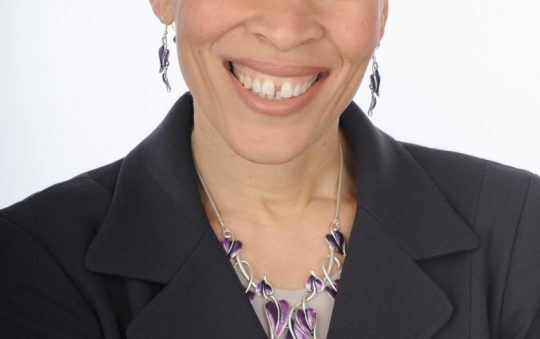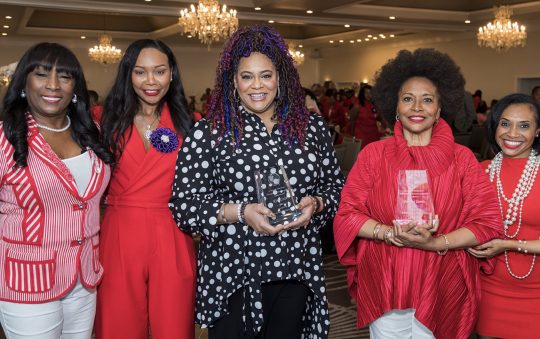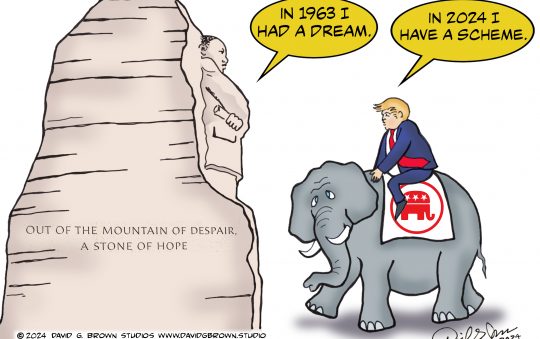The Los Angeles Sentinel recently held an editorial board meeting to address many residents’ concerns over the ongoing Expo-Line. Participating at the meeting on behalf of the Expo Line were Exposition Construction Authority CEO Samantha Bricker, Council members Bernard Parks (D-10) and Jan Perry (D-9) and representing the community were Cherisse Bremond-Weaver, president of the Brotherhood Crusade and activist Lillian Mobley. The meeting was conducted by Sentinel managing editor Kenneth Miller and assistant managing editor Yussuf J. Simmonds.
Sentinel: When did this project start and was an Environmental Impact Report/Statement (EIR/EIS) completed? Was community input included?
Expo: This project has been on the drawing board for many years. Metro acquired the Exposition railroad right-of-way from Southern Pacific railroad in 1991. Actual planning for the Expo corridor transit project started in 2000 and the draft environmental impact report was approved by the Metro Board in 2001. Metro received over 1,000 comments from residents and agencies during the environmental review process and responded to those comments in the final environmental document. This final environmental impact report was approved by the Metro Board in December 2005 and the Federal Transit Administration issued a Record of Decision on the project in February 2006. Construction on the project began in October 2006.
Sentinel: Many people in the community say they did not know about the project and were not invited to participate in meetings and decisions on the project. When did you initially reach out to the community about the project? How was this done?
Expo: Community participation is an important part of any major capital infrastructure project and community outreach is a high priority for the Expo project. As part of the planning process, Metro held 11 large scale community meetings along the Expo corridor, with over 850 attendees, from May 2000 through December 2002. A listing of these meetings is contained in the environmental documents. Further, working groups were formed during the planning process, which were comprised of residents, stakeholders and businesses along the corridor, who provided input into the project.
Since the Exposition Construction Authority began its operations in 2005, the community relations team has reached out to the community via quarterly project status meetings, delivery of flyers to residents and businesses within 1/4 mile of the alignment and advertising in local papers. The Authority has held 19 large scale community meetings and over 800 stakeholders have attended, since June 2006. Further, the community relations team has worked with all of the schools along the alignment and has distributed safety information relative to the project as well as other construction related information.
The staff has made presentations about the project at local homeowners groups, neighborhood councils, local businesses and faith based groups. The team has also made presentations to local chambers of commerce, senior citizen centers and community based organizations.
Sentinel: What is a stakeholder and how have stakeholders been involved in the project?
Expo: The Expo Line has many important stakeholders—residents, businesses, neighborhood groups, block clubs, churches and institutions —who may be impacted by the project. We have reached out to stakeholders in a variety of ways: through quarterly meetings, one-on-one briefings, presentations to their members etc. Some stakeholders have met as a group i.e. USC, the museums in the Expo Park, the Coliseum and Sports Arena) and have regularly scheduled meetings with the contractor and the Authority to receive updates on the project and ensure that their concerns and interests are addressed.
The Expo Authority Board appointed 14 members to participate in an Urban Design Committee, comprised of residents, community members, business representatives, faith based representatives and others along the entire alignment, to provide input into the design, landscaping and aesthetics of the project. This group has met for two years and has been instrumental in shaping the look of the stations, art, and landscaping for the project.
Parents are also important stakeholders and the community relations team has developed safety information, distributed materials and information, and briefed parents at School Site Council and PTA meetings regarding upcoming construction activities and other issues pertaining to the project.
Sentinel: What are you doing to ensure that this project is safe and the community is protected?
Expo: The Expo Line will be a state of the art rail line employing the latest technology. The line will include the same safety features as the Pasadena Gold Line, which is one of the safest light rail lines in the country. Safety features include LED train approaching lights, photo enforcement at signal controlled crossings, left turn pockets and left turn arrows at all at-grade crossings where left turns are permitted as well as signage, striping, enhanced crosswalks, and pedestrian countdown timers. At the gated crossings, there will be both vehicle and pedestrian gates as well as warning bells and horns.
Sentinel: How will the train travel through the community and how fast will it go?
Expo: Light rail typically operates in street running mode or in semi-exclusive right-of-way. When the light rail is “street running” the line travels parallel to the street and the train operates with the traffic signals. For example, near Western, the train will be traveling at the posted street speed limit (not-to-exceed 35 mph) and will travel with the vehicles on the parallel street. When the traffic lights are green on Exposition, the train will move with the vehicular traffic. When the traffic lights are red, the train will stop. At these crossings there will be pedestrian countdown timers and train approaching signs. No gates are necessary in these street running sections since the train will be moving with parallel traffic. The street running section is roughly from the Pico Station downtown to Gramercy.
When the train is in semi-exclusive right-of-way, it can run at speeds up to 55 mph provided the right-of-way is fenced and the at-grade crossings are protected by gates. These quad gates have been successfully implemented on the Gold Line and prohibit drivers from driving around the gates. The gated section runs roughly from just west of Gramercy to west of Farmdale, with the exception of Crenshaw, which is signal controlled.
Sentinel: How does this project differ from the Blue Line, from a safety standpoint?
Expo: The Blue Line was built almost 20 years ago and technology has advanced substantially since then. The Blue Line has 104 crossings, while the Expo Line has only 38 crossings, including 11 grade separated crossings where the trains are separated from vehicles and pedestrians. The Blue Line is next to a freight railroad which causes more cars to try to go around the gates and “beat the train.” Expo Line does not share tracks with any other trains and is not near a freight railroad. Further, Expo Line has quad gates which go across the entire intersection and make it impossible for cars to drive around the gates and beat the train. The Blue Line does not have quad gates at all gated crossings.
The Expo Line is more similar to the Gold Line to Pasadena, which opened five years ago and has one of the best safety records in the country. Both the Gold Line to Pasadena and Expo lines feature quad gates, pedestrian gates and swing gates at the gated crossings in addition to the horns and warning bells. Both lines also feature LED Train Approaching signs as well as striping and signage. The Expo Line also has photo enforcement at all signal controlled crossings.
Sentinel: With the recent Metrolink tragedy, many residents are concerned about trains sharing tracks. Will the Expo Line share tracks with freight trains or will it have its own dedicated track?
Expo: The Expo Line will have its own dedicated track and will not share any track with freight trains.
Sentinel: What safety measures are you planning to have at the Farmdale Avenue crossing near Dorsey High School?
Expo: The current proposal, based on the certified environmental documents for the project approved by the Metro Board in 2005, is for the Farmdale crossing to be at-grade. The intersection is currently controlled only with a stop sign. Improvements for the intersection include signalization along with vehicle gates, pedestrian gates, LED train approaching lights and a pedestrian plaza for students to wait. Furthermore, Metro has offered to slow down the train to 10 mph in the hour when school starts and the hour in the afternoon when school lets out to ensure that students follow the rules. Further, Metro has offered to post Sheriff’s deputies at the crossing during these same time periods to ensure student safety. These safety features replicate similar safety features employed by the Pasadena Gold Line near Blair High School, which has a light rail crossing at-grade right near that school.
Sentinel: What safety provisions will the Expo Authority put in place to protect students near the Foshay Learning Center crossing?
Expo: There is a current underground pedestrian crossing at the Foshay learning center which is operated by LAUSD. The Expo Line will not alter that existing underground pedestrian tunnel. This tunnel is managed by the school and provides students with a dedicated crossing underneath the light rail line. There will also be a fence so that students cannot cross the street illegally in this area. There will also be at-grade crossings at Western and Denker, where the train will be traveling with the traffic signals at the posted speed limit not-to-exceed 35 mph, and students can cross with pedestrian countdown timers and signals.
Sentinel: We understand that Blair High School in Pasadena is near the Gold Line. How close is the school to the tracks? What safety measures are you providing at Blair that you are not providing near Dorsey High School?
Expo: Blair High School is near the Pasadena Gold Line but the students must cross the tracks to get to the bus drop off and pick up area. As a result, hundreds of students must cross the tracks each day. The safety measures being proposed for the crossing near Dorsey High School will exceed the safety measures that are in place at Blair High School.
Sentinel: Will the Expo Line turn into a subway near USC?
Expo: During the environmental planning phase of the project, it was determined that a grade separation was necessary at Figueroa and Flower based on traffic levels at these crossings. The complex geometry of the 110 Freeway offramps in that area makes it difficult to build an aerial grade separation. As a result, the grade separation will be in a shallow trench which will extend from south of Jefferson Blvd., will go under Figueroa and Flower and will surface at Trousdale Ave, which is in front of USC. USC had requested that the trench continue all the way to Vermont instead of surfacing at Trousdale. USC was told that the trench could continue to Vermont only if USC paid the cost differential of $120 million. USC declined to pay this cost so the line surfaces at-grade at Trousdale, which is right in front of USC. There is an at-grade station at Trousdale and the line continues at-grade to Vermont where there is also an at-grade station.
Sentinel: Why does the Expo Line only go underground near USC and not for the entirety of the project?
Expo: Light rail projects typically operate at grade. There are other at-grade light rail projects in Los Angeles County such as the Gold Line to Pasadena and all over the country, including Portland and Phoenix. In 2003 Metro adopted a grade crossing policy which developed objective criteria for determining when a crossing should be at-grade or grade separated. The criteria takes into account traffic, safety, engineering concerns and other issues. This grade crossing policy was applied to the Expo Line, and a grade separation at La Brea was added to the project, in compliance with the grade crossing policy. There are also grade separations at La Cienega, Flower/Figueroa and Venice/Robertson, all of which met the criteria of the grade crossing policy adopted by Metro.
Sentinel: What is the Expo Authority doing to reduce the impact of noise from the line?
Expo: The light rail trains are electric and so the trains themselves create very little noise. The California Public Utilities Commission (CPUC) requires bells to sound when a train approaches and crosses an at-grade crossing protected by gates. The CPUC also requires the train to sound a horn prior to entering the crossing. The Expo Authority has proposed stopping the warning bells once the gates are down and will apply to the CPUC to implement some of the measures successfully implemented by the Pasadena Gold Line, including the use of a quieter quacker horn on the trains in non-emergency situations and installing shrouds on the warning bells to focus the noise at the crossing.
The environmental document also identified areas along the alignment where noise will need to be mitigated. These mitigation measures include soundwalls, which are being built in the areas identified in the environmental document, such as residential areas.
Sentinel: What effect does this project have on air quality in our community?
Expo: Light rail trains are electric and so will have a beneficial impact on air quality in the community because it reduces the number of cars on the street that produce harmful emissions.
Sentinel: What are the economic benefits of the Expo Line for the community?
Expo: The Expo Line will provide enormous benefits to the community by providing reliable and affordable access to jobs, health care, and entertainment. Further, studies have shown that joint development opportunities around stations can revitalize neighborhoods, can provide live/work options, and attract businesses and other job opportunities. The Expo Line will link residents and businesses to other areas of the City and will connect to the Long Beach Blue Line, Red Line and regional transportation. Further, the Expo Line will connect people to businesses in the Crenshaw and Mid-Cities Communities which will spur economic growth. It will also provide an alternative to the heavily congested I-10 freeway and will allow easier and faster access to cities along the corridor such as Culver City, Exposition Park and eventually Santa Monica, when Phase 2 of the project is completed.
Sentinel: Have you hired people from this community to work on the project?
Expo: Yes. The Expo Authority has set a 30% local jobs program goal for the project, which the contractor has agreed to meet. This means that 30% of the work hours will be performed by those who live in zip codes along the Exposition corridor. As of September, the Expo project had 132 active workers and 26 or 19% were from Expo corridor zip codes. Out of the 132 active workers, 79 are minorities. All Expo jobs are union jobs and the contractor has sponsored 24 individuals into the local unions and has conducted orientation sessions with PVJobs to assess skill level and place interested individuals into construction jobs in the area. So far, over 1000 people have attended these orientation sessions and over 100 have been placed in local jobs.
Sentinel: Have you hired minority contractors to work on the project? What percent of your contractors are minorities?
Expo:There is a 20% DBE goal for design, professional services and construction. As of the end of August, over $58 million in subcontracts had been awarded to DBE firms. This contract amount will increase as additional construction work packages are awarded.
As of the end of August, there were 12 DBE firms with subcontracts totaling $6.2 million for design services. 10 of these 12 DBE firms are minority firms. There were 18 DBE firms with subcontracts totaling $7.2 million for professional services. 12 of these 18 firms are minority firms. There are 11 DBE firms that have subcontracts totaling $45.5 million. 6 of these 11 are minority firms. These numbers will continue to increase as additional construction work packages are awarded.
Sentinel: How were the artists selected for the project? How do we know they will reflect the culture and history of the neighborhoods along the project?
Expo: Metro formed art advisory panels, comprised of interested residents, stakeholders and arts community members, to develop profiles of all of the station areas, taking into account the culture and history surrounding the stations. There were also 3 special artist workshops held along the Expo Corridor, including one in Leimert Park. Metro issued a Call for Artists to over 3800 artists and arts organizations in California and advertised in several local papers seeking artists for the project. A total of 203 artists responded to request and a selection panel made up of arts professionals, artists, the Art Advisory Group and members of the Urban Design Committee reviewed their qualifications. Over 50 people participated in the selection process. Eight station artists were selected and 75% of the artist contracts being awarded are to minorities and women. The artists will meet with stakeholders and their concepts will be shown at community meetings so that the community can comment and provide input on their work.
Sentinel: There appears to be some community opposition to this project. What are the origins of the opposition? What is the basis for the opposition?
Expo: Large capital infrastructure projects inevitably generate community concern and in some cases, opposition. There is often concern by some residents regarding the change that the project will bring about in the community and fear of that change. In other cases, there are legitimate concerns regarding construction impacts, noise, safety, and traffic issues and it is our obligation to address these concerns and mitigate them to the extent possible.






